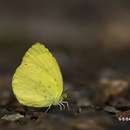pt-BR
nomes no trilho de navegação


முப்புள்ளி புல் மஞ்சள் அல்லது மஞ்சள் புல்வெளியாள் (Three-Spot Grass Yellow, [Eurema blanda]) என்பது இந்தியாவிலும் இலங்கையிலும் காணப்படும் வெள்ளையன்கள் (பியரிடெ) குடும்ப சிறிய வகை மஞ்சள் பட்டாம்பூச்சி.
இந்த மஞ்சள் புல்வெளியாள் வண்ணத்துப்பூச்சியின் முன் இறக்கையின் பின்புற உச்சியில் பழுப்பு நிறத் திட்டு இருக்கும். பருவநிலை உலர்ந்து இருக்கும்போது, இந்த பழுப்புத் திட்டை தெளிவாகக் காணலாம். முன்இறக்கைகளின் கீழ்ப்புறம் உடல் அருகே மூன்று புள்ளிகள் காணப்படுவதே இந்த புல்வெளியாள் வகையின் பெயருக்குக் காரணம். இந்த வண்ணத்துப்பூச்சி இறக்கைகளை மடித்து வைத்து இளைப்பாறுவதால் முப்புள்ளிகளை தெளிவாகக் காண்பது கடினம். இவை இறக்கையை விரித்தால் 4 செ.மீ.க்கும் குறைவாகவே இருக்கும்.[1]
முப்புள்ளி புல் மஞ்சள் அல்லது மஞ்சள் புல்வெளியாள் (Three-Spot Grass Yellow, [Eurema blanda]) என்பது இந்தியாவிலும் இலங்கையிலும் காணப்படும் வெள்ளையன்கள் (பியரிடெ) குடும்ப சிறிய வகை மஞ்சள் பட்டாம்பூச்சி.
Eurema blanda, the three-spot grass yellow,[3][4] is a small butterfly of the family Pieridae which is found in Sri Lanka, India and southeast Asia.[3][4][1][2]
Wet form: Male. Upper-side lemon-yellow. Fore-wing with the outer marginal black band anteriorly broader than in Sri Lankan specimens of Eurema hecabe, the posterior end shorter and its inner edge outwardly oblique. Hind-wing with a moderately broad black outer band. Underside. Both wings with more or less defined ordinary markings of wet form. Fore-wing with three marks in the cell, in addition to the discocellular. No sub-apical patch. Female. Not seen.
Intermediate form: Male. Not seen. Female. Upper-side. Fore-wing with similar outer band to the wet form. Hind-wing with a broad black outer marginal band. Underside with slightly-defined ordinary brown markings as in wet form. Fore-wing with a brown sub-apical patch.
Dry form: Smaller than in wet form. Male. Upper-side. Fore-wing with narrower outer marginal band, its posterior end much smaller. Hind-wing with a slender outer band. Underside. Both wings with similar ordinary markings to the wet form. Fore-wing with a more or less defined sub-apical patch. Female. Upper-side. Fore-wing with a broader black outer band than in male. Hind-wing with a much broader outer band than in male. Underside. Both wings similar to male.
Extreme Dry form: Male not seen. Female. Upper-side. Fore-wing with a broad black outer band, its posterior portion angled obliquely outward from the lower median veinlet. Hind-wing with a moderately broad outer band. Underside. Both wings with ordinary markings as in dry form. Fore-wing with a prominent almost complete quadrate apical brown patch.
Pale yellowish oval-shaped eggs are laid under or upper the leaves and hatch after about three days.
They are light green in color in first instar and they become bright green color in the last instar.
After 20 days from the hatching , the larva become pupa. Pupae are light green in color and , they become butterflies and emerged from the chrysails after a week.
Caesalpinia mimosoides and Bauhinia purpurea.[5]

Eurema blanda, the three-spot grass yellow, is a small butterfly of the family Pieridae which is found in Sri Lanka, India and southeast Asia.
Eurema blanda est un petit papillon d'Inde et de la famille des Pieridae.
Dans la forest de Talakona (en) forest, dans le district de Chittoor à Andhra Pradesh en Inde.
Dans la forest de Talakona (en) forest, dans le district de Chittoor à Andhra Pradesh en Inde.
À Narendrapur (en) près de Calcutta dans le Bengale-Occidental en Inde.
Sur une Synedrella nodiflora à Calcutta dans le Bengale-Occidental en Inde.
À Calcutta dans le Bengale-Occidental en Inde.
À Calcutta dans le Bengale-Occidental en Inde.
Eurema blanda et Vespidae sur une tagète lucida, au Laos.
Eurema blanda (Anglice three-spot grass yellow) est parvus familiae Pieridarum papilio, in India endemicus.
Larvae Caesalpinia mimosoide et Bauhinia purpurea vescuntur.[1]
Eurema blanda in silva Talakona in Districtu Chittoor Andhra Pradesh Indiae.
Eurema blanda in silva Talakona in Districtu Chittoor Andhra Pradesh Indiae.
Eurema blanda in Narendrapur prope Kolkata, Bengalia Occidentalis, Indiae.
Eurema blanda in Synedrella nodiflora Kolkatae, Bengalia Occidentalis, Indiae.
Eurema blanda Kolkatae, Bengalia Occidentalis, Indiae.
Eurema blanda Kolkatae, Bengalia Occidentalis, Indiae.
Eurema blanda (Anglice three-spot grass yellow) est parvus familiae Pieridarum papilio, in India endemicus.
Larvae Caesalpinia mimosoide et Bauhinia purpurea vescuntur.
Eurema blanda, atau Three Spot Grass Yellow, adalah kupu-kupu yang termasuk dalam kelompok keluarga Pieridae dan sub-keluarga Coliadinae. Ia mempunyai lebar sayap sekitar 35–45 mm.[1]
di hutan Talakona, di daerah Chittoor Andhra Pradesh, India.
di Narendrapur hampir Kolkata, Bengal Barat, India.
di Synedrella nodiflora (rumpai Cinderella) di Kolkata, Bengal Barat, India.
di Kolkata, Bengal Barat, India.
di Kolkata, Bengal Barat, India.
Eurema blanda, atau Three Spot Grass Yellow, adalah kupu-kupu yang termasuk dalam kelompok keluarga Pieridae dan sub-keluarga Coliadinae. Ia mempunyai lebar sayap sekitar 35–45 mm.
Eurema blanda is een vlindersoort uit de familie van de Pieridae (witjes), onderfamilie Coliadinae.
Eurema blanda werd in 1836 beschreven door Boisduval.[1]
Bronnen, noten en/of referenties
Eurema blanda é uma pequena borboleta da família Pieridae,[3] com distribuição natural no Sri Lanka, Índia e sudeste da Ásia.[4][5][1][2] A espécie foi descrita por Jean Baptiste Boisduval em 1836,[3][6] não estando presentemente listada qualquer subespécie no Catalogue of Life.[3]
Esta borboleta alimenta-se de folhagem das espécies Caesalpinia mimosoides e Bauhinia purpurea.[7]
|hämtdatum= ignorado (ajuda) !CS1 manut: Nomes múltiplos: lista de autores (link) Eurema blanda é uma pequena borboleta da família Pieridae, com distribuição natural no Sri Lanka, Índia e sudeste da Ásia. A espécie foi descrita por Jean Baptiste Boisduval em 1836, não estando presentemente listada qualquer subespécie no Catalogue of Life.
Three-Spot Grass Yellow, Eurema blanda là một loài bướm thuộc họ Pieridae, có màu vàng và trắng, được tìm thấy ở India.
Caesalpinia mimosoides and Bauhinia purpurea.[1]
in Talakona forest, in Chittoor District of Andhra Pradesh, Ấn Độ.
in Talakona forest, in Chittoor District of Andhra Pradesh, Ấn Độ.
at Narendrapur near Kolkata, West Bengal, Ấn Độ.
on a Synedrella nodiflora (Cinderella weed) in Kolkata, West Bengal, Ấn Độ.
In Kolkata, West Bengal, Ấn Độ.
In Kolkata, West Bengal, Ấn Độ.
Phương tiện liên quan tới Eurema blanda tại Wikimedia Commons
Three-Spot Grass Yellow, Eurema blanda là một loài bướm thuộc họ Pieridae, có màu vàng và trắng, được tìm thấy ở India.